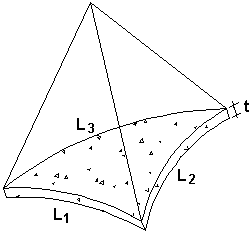Shotcrete Support Force
The assumed mode of failure for shotcrete in UnWedge is direct shear. The area of shotcrete the wedge has to shear through is given by the product of the perimeter of the exposed face and the thickness (t) of the shotcrete (see figure below). The shotcrete acts in a direction normal to the excavation wall that it is supporting. For a flat exposed face, the total shotcrete capacity is given by:
![]()
where ![]() is the shear strength of the shotcrete. For a wedge with a non-flat exposed face (piece-wise linear), the capacities of each segment are added vectorially and the shotcrete acts in the direction of the resultant vector. The resultant shotcrete support force is always included as a Passive force in the UnWedge analysis.
is the shear strength of the shotcrete. For a wedge with a non-flat exposed face (piece-wise linear), the capacities of each segment are added vectorially and the shotcrete acts in the direction of the resultant vector. The resultant shotcrete support force is always included as a Passive force in the UnWedge analysis.

Estimating Shotcrete Shear Strength
To estimate the value of shotcrete shear strength, there are a variety of different codes that relate concrete compressive strength to shear strength. The Canadian CSA simplified standard is shear strength(MPa) = ![]() where f'c is the 28-day compressive strength in MPa. For example, given 35MPa unreinforced shotcrete, the shear strength is approximately 1.2 MPa. ACI and Eurocode are similar.
where f'c is the 28-day compressive strength in MPa. For example, given 35MPa unreinforced shotcrete, the shear strength is approximately 1.2 MPa. ACI and Eurocode are similar.
Shotcrete Failure Modes
It is important to note that the only shotcrete failure mode which is considered in UnWedge, is the direct shear failure mode, as described above. The direct shear failure mode is applicable when the shotcrete is well bonded to the rock (i.e. loss of adhesion does not occur at the shotcrete/rock interface, and therefore failure can only occur by direct shear through the shotcrete).
Other shotcrete failure modes are possible, which can decrease the effective support force of the shotcrete. This depends on factors such as the quality of shotcrete application and surface preparation (cleaning) of the rock surface prior to shotcrete application. If loss of adhesion occurs at the shotcrete/rock interface, then shotcrete can fail in flexure or more complex multiple failure modes. If shotcrete fails in flexure, the effective support force provided by the shotcrete will be LESS THAN the support force calculated using the direct shear assumption.
UnWedge does NOT provide explicit modelling options for shotcrete failure modes other than direct shear. If you wish to model the support force resulting from other shotcrete failure modes (e.g. flexural failure), there are two possible methods of accomplishing this:
- Use the Shotcrete option in UnWedge, and enter a reduced value of shotcrete shear strength, to simulate a reduced support force due to flexural failure for example.
- Use the Pressure option in UnWedge, and enter an equivalent support pressure provided by the shotcrete, taking into account the exposed face area of the wedge.
In either case, it will be necessary to estimate the shotcrete support capacity for a particular failure mode assumption.